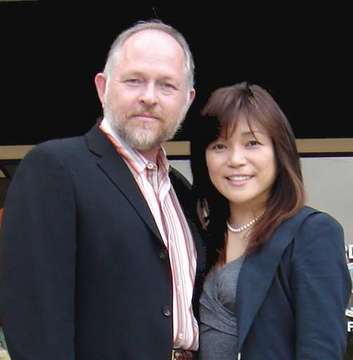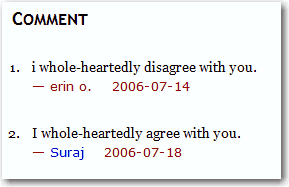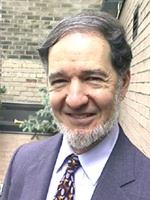Bob and Sakiko get married
January 18th, 2006 Bob and Sakiko got married on Tuesday, November 14, 2006.
Bob and Sakiko got married on Tuesday, November 14, 2006.

 Bob and Sakiko got married on Tuesday, November 14, 2006.
Bob and Sakiko got married on Tuesday, November 14, 2006.
 I’d like to thank the readers of Numenware for their insightful comments and the value they add to the blog.
I’d like to thank the readers of Numenware for their insightful comments and the value they add to the blog.
Actually, the greatest number of comments came on an obscure post about a trivial English grammar issue. For some reason, huge numbers of readers from India believed I was offering some kind of English lessons. I wish I could figure out how to monetize these guys!
Next most popular was 34 readers commenting on my post about Charles Shaw’s $2 wine. Must have gotten picked up somewhere. As long as they click on my Google ads, I’m fine.
My post on sushi restaurants near my house generated 24 comments. My favorite was
My two interests are Neurotheology and Sushi and those two roads have guided me to this informative website….
Thought-provoking comments included those on the article Science and Buddhism on craving and suffering and The End of Faith. On my post on Bill O’Reilly: unlikely neurotheology advocate , the actual interviewee who appeared on Bill’s program made a comment. Some of the comments were very personal: on Religious music in your brain, one reader commented:
I am constantly hearing Christmas and religious hymns whenever I am not concentrating on a task. I also hear some old popular songs ‘Tammy’ & “The Bells of St. Mary’s”, “Star Spangled Banner” Every tune is in the same beat of 3/4 time. How do I stop this, it is driving me mad.
No one bothered to comment on one of my favorite posts, God and the brain in your gut, although it got some trackbacks. Nor on Peak experiences on mountain peaks , although it got picked up by Mind Hacks, nor on the article about dried squid entrails. My post about Sanyo: washing machines and global symbiosis yielded a request for a user’s manual for one of their washing machines.
The longest comment, by far, was on my post Book review: Living with the Devil , where Nordron, a Buddhist monk from Dharmasala, gave a thoughtful, detailed Buddhist perspective. Rhawn Joseph himself commented on my post about him and warned me that the picture I was using was wrong (since fixed).
I have been blessed with thoughtful, informative comments which add, I think, to the overall value of the blog, and not too many of them to be overwhelming. Thank you again.
 It’s time to play another game of “what would Dogen have really been saying”! Here are your choices:
It’s time to play another game of “what would Dogen have really been saying”! Here are your choices:
1. Time is like a mountain range you can look out across; it does not simply recede into the past.
2. Time is not like a mountain range you can look across, fading into the distance.
This, of course, is from Uji , where Dogen writes ã??ã?®æ˜¨ä»Šã?®é?“ç?†ã€?ã?Ÿã? ã?“れ山ã?®ã?ªã?‹ã?«ç›´å…¥ã?—ã?¦ã€?å?ƒå³°ä¸‡å³°ã‚’ã?¿ã‚?ã?¤æ™‚節ã?ªã‚Šã€?ã?™ã?Žã?¬ã‚‹ã?«ã?‚らã?šã€‚
Nearly all translations take the interpretation that time is like a postcard of a mountain range. Nishijima/Cross:
Even so, this Buddhist principle of yesterday and today is just about moments in which we go directly into the mountains and look out across thousand or ten thousands peaks; it is not about what has passed.
This is a serviceable translation, with the minor exception of being wrong. The principle is not about moments where we saw the mountains; it is that past and present are (or are not) the mountain view. More importantly, they reverse (in my opinion) what Dogen is saying about mountains and time.
Tanahashi/Welch somehow manage to mangle this sentence even more badly:
Yet yesterday and today are both in the moment when you directly enter the mountains and see thousands and myriads of peaks. Yesterday’s time and today’s time do not go away.
They completely leave out the word “concept” from the original; transform past and present needlessly into yesterday and today; mistranslate jisetsu as “moments”; have time being “in the moment” rather than “the case of”; and introduce a gratuitous sentence break—a sure sign that their parsing is off. The awkward “thousands and myriad” just adds insult to injury. Someone should take away these guys’ translating license.
But the real question is whether time is, or is not, like the series of mountain peaks. The syntactic problem here is that the Japanese has the structure “doing A, doing B not,” where A is the mountains and B is passing away. This gives rise to an intrinsic ambguity: it could be “(doing A, doing B) NOT” or “doing A, (doing B NOT).”
Beyond the syntax, however, there are a number of clues for us here. First and foremost, Dogen has spent the entire preceding part of the essay telling us precisely that time is not a linear sequence—which is exactly what the range of peaks is! The sentence starts off with a “but” which makes sense only if the sense of the entire sentence is negative. And the word “simply” (J. tada) right at the beginning—which Tanahashi/Welch toss away—pairs naturally with the “not” at the end.
Therefore, I believe that the “not” in the original extends to both time passing away and the view of time as a linear series of mountain peaks. Sorry if you were liking the analogy of past and present as a mountain range.
My translation would be:
But do not conceive of past and present simply as a vista of a innumerable peaks that you look out over from within the mountains, receding off into the distance.
This is somewhat disconcerting. Typically different interpretations might yield a shift in nuance or emphasis. But here they are diametrically opposed. And impeccably credentialed Zen masters and eminent scholars all assure us that Dogen is in fact exhorting us to rush out into the wilderness and gaze on mountain ranges as an excellent analogy for how time works.
What is a student to do? Simply understand the potential issue and make up your own min—assuming the translator deigns to point out the problem to you as I am doing here.
 Last week, I proposed 25 research topics for neurotheology . The underlying theme was to find phenomena somehow related to religion—for instance, speaking in tongues occurs in explicitly religious contexts, while some schizophrenics display quasi-religious behavior—and then inquire as to the neural bases of those phenomena.
Last week, I proposed 25 research topics for neurotheology . The underlying theme was to find phenomena somehow related to religion—for instance, speaking in tongues occurs in explicitly religious contexts, while some schizophrenics display quasi-religious behavior—and then inquire as to the neural bases of those phenomena.
There is a single researcher who has addressed many more of these topics than any other: Julian Jaynes (picture; Wikipedia entry).
Jaynes was a psychology professor most noted for his book The Origin of Consciousness in the Breakdown of the Bicameral Mind, where he laid out his astonshing thesis that consciousness is of recent origin (three millennia ago), and replaced internal voices as the basic means of human self-control. These internal voices were what were referred to as gods, and, he claims, the predecessors of the variety of gods people worship today.
Of course, many people think Jaynes is simply a crackpot; see this Salon article by Mark Wallace for an example. But these critics really need to come up with better attacks. For instance, Wallace says that “Jaynes displays a hallmark trait of the crackpot authority in drawing from widely disparate disciplines to back up a hypothesis that would never even occur to most scientists.” That’s supposed to be bad?
The illustrious Daniel Dennett, for one, is a Jaynes fan, and in his article about Jaynes reprinted in Brainchildren ) he provides a highly succinct summary of Jaynes’ hypothesis: that the human brain has gotten a “software upgrade” in recent millennia, while suggesting that many of the details of Jaynes’ theory—even the supposed centerpiece involving auditory hallucinations—are optional.
It is not at all surprising that Jaynes covers nearly half of the issues in my list of 22 research topics for neurotheology: mental illness, brain pathology, hallucinogens, polytheism, hypnosis, music, genetics, speaking in tongues, and at least one I omitted, poetry. Not surprising because Jaynes, in a way, is the original neurotheologist par excellence. In spite of its title, his book is not really about consicousness; indeed, Jaynes spends the entire first chapter making the point that consciousness, appropriately defined, is basically just a tool we humans use to do some things more effectively, but is hardly at the core of our experience.
Instead of consciousness, what the book is really about is God, or god, or gods, how they functioned before the advent of consciousness as we know it today (as verbalized messages from the right brain to the left), and how their vestiges constitute what we think of as religion today. In other words, “Breakdown” is really the “Bible”, so to speak, of neurotheology.
Love Jaynes or hate him, his theory remains, after 30 years, indisputably the single most comprehensive, wide-ranging, imaginative hypothesis available.
Reading this book, I had the uncanny feeling that perhaps our country is slipping back into bicamerality—by which I don’t mean having two houses of Congress, but rather Jaynes’ pre-conscious state. After all, we now have a President who said he was “told” by “God”—a voice, in other words—to invade Iraq, and a country which responded by electing him to another term.
 Jared Diamond (picture, Wikipedia entry) has written Collapse, a book about how societies fail, following on the heels of his previous Guns, Germs and Steel, which addressed the other side of the same question—why some societies succeeded. (That book, by the way, has a great section on the Incan empire and its defeat by the conquistadors.)
Jared Diamond (picture, Wikipedia entry) has written Collapse, a book about how societies fail, following on the heels of his previous Guns, Germs and Steel, which addressed the other side of the same question—why some societies succeeded. (That book, by the way, has a great section on the Incan empire and its defeat by the conquistadors.)
My interest is in how religion relates to a society’s success or failure. Unfortunately in “Collapse” Diamond deals with this question only tangentially. The examples he gives, however, do not speak well for religion. For instance, he attributes much of the blame for the collapse of the Norse society which existed in Greenland during the first half of the last millennium to the overinvestment in Christian infrastructure: the building of large churches, the undertaking of dangerous expeditions to acquire walrus tusk to trade for religious ornamentation. Similarly, the death of the civilization on Easter Island can also be attributed to religious factors, at least to the extent the motivation for building the huge stone statues was religious in nature. Building the statues consumed huge amounts of manpower and natural resources. In contrast, the societies he presents as relatively successful—including Tokugawa-era Japan, which he praises for its forestry policies—had weak religious infrastructures.
At the same time, it’s worthy of note that none of the societies Diamond identifies as political and environmental disasters are Buddhist.
Overall, “Collapse” is a worthy successor to “Guns, Germs and Steel”, although it tends to bog down in places. The focus is overwhelmingly on ecological/environmental issues, which account for three of the five causes Diamond identifies for societies collapsing:
Fine, but in his conclusions—basically, that the world faces an environmental crisis that threatens its collapse, albeit one that he bravely claims we can deal with—he entirely ignores his third factor, hostile neighbors, which would seem to be of prime importance given the current wave of global terrorism. He mentions terrorism of course, but only in the context that environmental depradations and the ensuing poverty can give rise to it. But the Saudis who flew airplanes into buildings suffered from neither.
Concerning his fifth point, society’s response to environmental problems, Diamond does mention political and organizational factors in the form of e.g. NGOs working to conserve natural resources, but, oddly, fails to address how a country’s political system affects its response (other than mentioning how poorly the USSR did environmentally). He does praise the conservation policies of noted autocrat Balaguer in the Dominican Republic, but fails to ask the obvious question: to what extent is democracy the best political system for dealing with environmental issues? Presented with a potential choice between some political prisoners rotting in jails and environmental devastation destroying a society, which would you choose? And of course Diamond talks at length about the impact of overpopulation on the environment, but fails to address how either it, or technology which allows information to be transmitted instantaneously and virtual groups to be formed overnight, affect the political and decision-making dynamic.
The elephant in the room, of course, is the impact of race. “Guns, Germs and Steel” went to great lengths, to the extent it can almost be read as an anti-racism manifesto. to make the point that Europe did not succeed because the Caucasians there were smarter than, say, native Americans, but rather because of factors such as flora, fauna, and geography. In “Collapse”, we are similarly told that Haiti is a failed country not due to any lack of giftedness on the part of its citizens but rather as a result of colonial history, climate, and the like.
But as the world becomes flat, in Thomas Friedman’s term, and globalization continues its inexorable progress, with people, information, products, resources, and money flowing like water across borders, making historical and geographical factors less important than ever before, what are the remaining factors that will dictate a country’s success ?
 What does it mean to say someone is divine, a living God? That they share God’s infallibility, or compassion, or wisdom, or omniscience, or power?
What does it mean to say someone is divine, a living God? That they share God’s infallibility, or compassion, or wisdom, or omniscience, or power?
From the neurotheological standpoint, the question we want to ask is what mental state do people enter when they view a human they consider godly? This should be easy to “divine” with current neuroimaging techniques. And the results might well cast light on the experience of the non-embodied divinity as well.
We have such a living God in the form of the late
Showa Tenno (picture), commonly known as “Hirohito” in the West. Although he renounced his divinity in the famous ningen sengen, or “declaration of humanity” (人間宣言), there are still many Japanese, most already in their 80s or 90s, that continue to believe him an arahitogami, or “human god” (ç?¾äººç¥ž), the latest in the long line of descendants of the mythical Amaterasu. And no small number may believe the same of his son and current Tenno Heika (official site), no matter what the Constitution may say.
As part of our program of neurotheological research, let’s grab those old Japanese folks before they die, toss them in an MRI machine, and make sure we take a neurological record of their reaction to viewing pictures of the man they believed was God.
 What is the mechanism by which meditation enhances brain function ? At the Investigating the Mind conference held in Washington DC in November 2005, sponsored by the Mind and Life Institute , Dr. Wolf Singer (picture), Director at the Max Planck Institute for Brain Research in Frankfurt, presented an intriguing hypothesis.
What is the mechanism by which meditation enhances brain function ? At the Investigating the Mind conference held in Washington DC in November 2005, sponsored by the Mind and Life Institute , Dr. Wolf Singer (picture), Director at the Max Planck Institute for Brain Research in Frankfurt, presented an intriguing hypothesis.
Dr. Singer’s research focus is the so-called binding problem: how are processes integrated within the distributed cortical architecture? His theory is that precisely calibrated neural clocks serve to coordinate the massive number of parallel, distributed subprocesses in the brain . Stated differently, various parts of the brain work together—talk to each other—by operating at the same frequency, sort of like neural walkie-talkies.
The frequencies Singer has identified as serving the integrative function are in the beta- and gamma frequency range . That’s interesting because gamma frequencies have also been identified as those enhanced by meditative practice (previous post).
This leads to a radical new hypothesis for how meditation enhances brain function: it improves synchronization, boosting the efficiency with which the parts and processes of the brain can work together.
 Clearly drugs cannot contribute to enlightenment. Right? According to James Austin’s new book, “Zen-Brain Reflections,” which I posted on here, zig-zag Zen is a “cultural aberration”, the term “entheogen” “camouflages” “ungodly hallucinations”, LSD causes bad trips, which studies such as Pahnke’s ignored, drugs amplify delusion, LSD is dangerous because it promotes the idea that reality is something to be maninpulated rather than accepted…and may leave you nuts, and on and on. He quotes Blake negatively, saying that his statement that “if the doors of perception were cleaned” involves a “very big if”.
Clearly drugs cannot contribute to enlightenment. Right? According to James Austin’s new book, “Zen-Brain Reflections,” which I posted on here, zig-zag Zen is a “cultural aberration”, the term “entheogen” “camouflages” “ungodly hallucinations”, LSD causes bad trips, which studies such as Pahnke’s ignored, drugs amplify delusion, LSD is dangerous because it promotes the idea that reality is something to be maninpulated rather than accepted…and may leave you nuts, and on and on. He quotes Blake negatively, saying that his statement that “if the doors of perception were cleaned” involves a “very big if”.
The biology of religion, however, provides a different perspective. It says that meditation or other spiritual practices cause plasticity-based changes in the brain which promote well-being and/or happiness. There should be no difference if those same changes are occasioned by drugs. There are no a priori grounds for asserting that drugs could not produce equivalent changes in the brain, behavior, and state of life.
Leaving aside arguments along the lines of “I meditated for 20 years to get where I am and I’ll be damned if someone can get there overnight by ingesting psilocybin,” we must examine carefully the arguments for or against drugs being a positive element in spiritual development.
One counterargument is that drugs produce a one-time effect which quickly wears off. But kensho is also a one-time effect, which must be built upon, and there is no obvious reason why drug-induced experiences could not be similarly built upon. Indeed, all of our experiences are “one-time.”
Others argue that drug-based enlightenment experiences simply cannot, by definition, measure up to the “real thing.” But why not, if they are functionally or descriptively identical?
Let’s approach this scientifically. Assume that there is an inherent temporal limitation in the ability of the brain to adapt. In other words, certain types of brain changes require a specific, finite amount of time to take effect. This would seem to support a model of only meditation one, two, four, eight, or sixteen hours a day over years or decades being capable of causing those changes. That may well be the case. But people making this argument provide no neuroscientific evidence whatsoever concerning such required durations for neural modifications. It could just as easily be the case that drugs could in fact accelerate such structural changes in the brain. Or, perhaps extended, incremental drug use could yield equivalent neural restructuring: four pills a day instead of four meditation periods.
An argument with which I can agree is that some people may view drugs as a shortcut, and imagine that they can achieve happiness and understanding through their weekly trip, without bothering to take responsibility to work through issues and manage their own spiritual development. But that is certainly not an indictment of a drug-based approach per se, only of how a certain subset of people try to take advantage of it.
At the end of the day, it seems counterintuitive that selective, disciplined use of psychopharmaceuticals could not play a role in a program of spiritual evolution. Dogen’s zazen has been passed on nearly unchanged for close to a millenium; certainly there is room for the blessings of modern science now to make their contribution.
Image of James Fadiman.
 Translating Dogen demands a philosophy of translation. Many of those translating Dogen are not professional translators, which perhaps is why we so often fail to see coherent philosophies being applied.
Translating Dogen demands a philosophy of translation. Many of those translating Dogen are not professional translators, which perhaps is why we so often fail to see coherent philosophies being applied.
The simplistic choice is between “literal” and “paraphrased” translations. These styles have names: formal and dynamic equivalence, or “form equivalence” and “functional equivalence”. Sometimes the terms “word for word” and “thought for thought” are seen as well.
The debate between the two schools is heated and often uninformed. The literalists accuse the paraphrasers of inserting their own opinions into the translation. The paraphrasers respond that the literalists create wooden translations that no one wants to or can read.
There are problems with both sides of course. No translation can be completely literal, since it must use the vocabulary and syntax of the target language. And if the objective of the paraphrasers is to “create the same effect in the mind of the reader of the translation as the original did in the mind of its,” clearly this is impossible given that the readers exist in different cultural and historical contexts.
Of course, which style to use depends on the goals of the translation and the target audience. A wider, more general audience would call for a more dynamic style, a narrower, more expert audience a more formal one. When the source and target languages are distant linguistically, a more dynamic style may be the only choice.
Dynamic equivalence was developed by the linguist Eugene Nida for Bible translation. He insisted that only this approach could create an approachable, meaningful Bible for the masses. Bible translations are clearly a useful analogy for translating Dogen. An interesting approach developed for the God’s Word translation is called closest natural equivalence translation.
Closest natural equivalence claims to achieve the following:
CNE asserts that an awkward translation by definition is not faithful to the original, while at the same time natural-sounding language in and of itself never suffices to make a translation good.
The obvious objection is that it may not be possible to convey meaning accurately in natural sounding language. I would assert, however, that it is simply a matter of time and effort on the part of the translator. It should not be out of the question to spend an hour, or even a day, on a single sentence. Naturally, this reduces translator throughput dramatically. It is striking, however, how in many cases, once the effort is made, the resulting natural English undeniably conveys the meaning of the original in a way much more compact and compelling that a mechanical translation might.
The web page quoted above ends with a caveat:
Translation can never be completely objective. Even when operating under the assumptions of closest natural equivalence, translators cannot produce a perfect translation. Translators use cautious judgment and maintain a keen awareness of all the factors needed for a full understanding of the source text. Among other things, translators need to understand the original language’s grammar and syntax, appreciate and understand literary devices used by the original authors, understand what kind of audience the original author had in mind when writing, and understand the modern target audience and its language. Because these factors call for balance and judgment, every translation (even those produced using closest natural equivalence) can be improved.
 Mirror neurons (Wikipedia) are magical brain cells that fire both when performing some act and watching someone else perform it.
Mirror neurons (Wikipedia) are magical brain cells that fire both when performing some act and watching someone else perform it.
In this sense, they can be viewed as the key to learning and sharing behavior, tying the acts we perform to those of others and vice versa. Scholars such as M. Arbib have even proposed that they lie at the heart of language.
Now the NYT, in a Jan. 10 article entitled Cells That Read Minds , has given us a competent, if brief, overview of the field. This has been quite widely blogged.
What’s the neurotheology connection? Normally we think of mirror neurons as being activated via everyday motions such as reaching for a cup, or sticking out your tongue—something even one-day-old babies can imitate.
But what about religious behaviors? Such as bowing, prostrating yourself, or placing your hands together in prayer? If such motions stimulate mirror neurons, especially in young children, there may be grounds to argue that these are hard-wired physical behaviors.